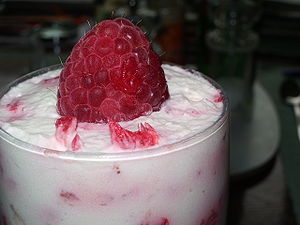|
Fruit fool
A fool is an English dessert. Traditionally, fruit fool is made by folding puréed stewed fruit (classically gooseberries) into sweet custard. Modern fool recipes often use whipped cream instead of custard. Additionally, a flavouring such as rose water may be added. EtymologyThe reason the word "fool" is used for this fruit dessert is unclear. Several authors believe it derives from the French verb fouler meaning "to crush" or "to press" (in the context of pressing grapes for wine),[1] and Alan Davidson argues that it is 'reasonable to suppose that the idea of mashed fruit was there from the start' but also points out that Norfolk fool, a type of bread pudding, contained no fruit.[2] while this derivation is dismissed by the Oxford English Dictionary as baseless and inconsistent with the early use of the word.[3] The name trifle was also originally applied to the dish, with the two names being used, for a time, interchangeably.[4] In the late 16th century, a trifle was 'a dish composed of cream boiled with various ingredients'. Davidson suggests that this is 'also the description one could give of a fool'. In support for this theory, Davidson quotes John Florio from his dictionary of 1598: 'a kinde of clouted cream called a fool or a trifle'.[2] History'Foole' is first mentioned as a dessert in 1598, made of 'clouted creame'[3] although gooseberry fool may date back to the 15th century.[5] The earliest recipe for fruit fool dates to the mid-17th century.[6] The soft fruits used in fools in the sixteenth and seventeenth centuries were often boiled and pulped before being mixed with the cream. It was considered the most 'prudent' way to eat fruit at the time as there was a fear that raw fruit was unhealthy.[7][2] Fruit fools and creams, argues food historian C. Anne Wilson, 'succeeded the medieval fruit pottages. They were based on the pulp of cooked fruits beaten together with cream and sugar. Gooseberries, and later orange juice combined with beaten eggs, were made up into fools.'[7][2] The cream in earlier fools was often unwhipped. The process of whipping cream before forks were adopted in the late 17th century was long and difficult.[2] The eggs used in many earlier fool recipes became less common, and now most fools are made without them.[2] Variations Originally, the most common fruit ingredient in fools was gooseberries, although other fruits and berries are known from early recipes, e.g., apples, strawberries, rhubarb and raspberries. Modern recipes may include any seasonal fruit readily found.[8] In Anglo-Indian cuisine, mango fool is a popular variation.[9] Norfolk fool[10] is an old local variation of the fruit fool, often containing minimal or no fruit.[2] It is seasoned with spices, such as mace and cinnamon, and thickened with eggs and boiled. [11][7] The original recipe can be found in The Accomplisht Cook by Robert May 1660:
See also
References
External links
|
||||||||||||||
